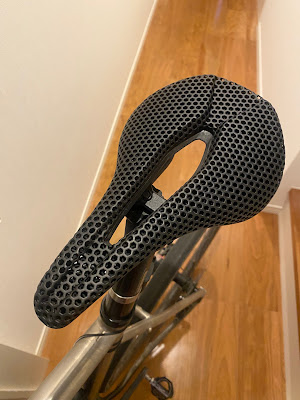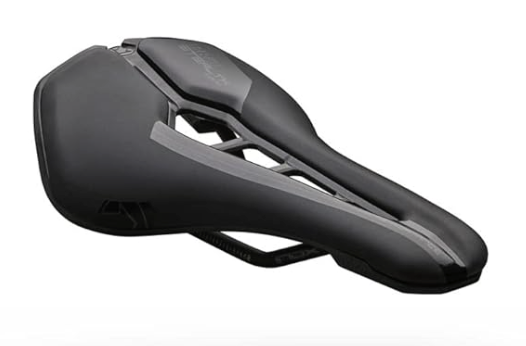I have yet to write up my PBP adventure of 2023. I DNFed after Loudeac and before Brest, just under 500kms. The main problem was with my left wrist -- a lingering injury that turned out to be a scaphoid fracture but had not shown up on an earlier x-ray.
A secondary problem was chafing/saddle sores that made it painful at times to ride — made much worse by my inability to ride out of the saddle due to the wrist injury, and a very hot afternoon on the stretch before Loudeac. I had the same issue in 2019, much later in the ride, with the same saddle on the same bicycle. That is a Fizik Arione model that is just slightly wider (and interferes just slightly more with my leg motion) than the classic, original Arione. And the saddle cover is slippery/smooth on top, bit a bit grippy on the sides where the legs should slide smoothly. Also, the narrow front part of the saddle is a bit wider and protrudes more than on the "Classic" version.
 |
| The wider Arione w/ grippy sides and the more-bulbous front. 209 grams. Worked fine on many rides ... but problematic on the longest randonees. |
As mentioned years ago, the classic Arione (the "good" Arione) has been my long-time go-to saddle. I rode 205kms yesterday on one and it fit me absolutely fine.
 |
| The Classic Arione. 225 grams and worth it. |
But I have my doubts whether the Classic Arione can continue to be my go-to.
--First, Arione model types have proliferated, and most of them do not work at all well for me. The "classic" Arione is not easy to find these days. Sure, I only need one every other year or so, but at this point I cannot find one in stock anywhere.
--Second the Arione is said by Fizik to be appropriate for the most flexible "snake"-like cyclists. I am toward the other end of the flexibility spectrum.
--Third, saddle styles have changed a lot in the past decade. The Arione is a long (30cm) and flat saddle. That has the benefit of allowing the rider to shift forward and back, relieving pressure and getting some variation over a long ride. But it also means that the rider is not "dialed in" to a "proper" position. Now, shorter saddles that put the rider in such a position have proliferated and seem favored by bike-fitters and many riders. These nearly all have a "cut out" or "channel" in the middle to avoid numbness or pressure on the most sensitive parts of the anatomy. If your butt gets sore ... you get out of the saddle briefly instead of shifting back and forth. And the shorter saddle makes it easier to lean forward into an aerodynamic/racing position without putting pressure on your sensitive parts.
I ordered two of the shorter saddles during my injury-forced time off the bike.
The first is a Fizik "Argo Tempo Kium R3". It is 265mm long, 150mm wide, and has a large cut-out. It is designed for endurance rides and has a bit more padding than Fizik's racing models. It is stated as 229 grams, but mine weighs 243. The cover is very smooth, almost slippery. This contrasts with the more grippy "suede" feel of the middle strip of the Classic Arione. How do I like it? It is OK. There is nothing particularly uncomfortable when used on the shorter rides I have taken, but I find the edges around the large cut out to be quite sharp in shape, so I feel a bit as if I am sitting on two sharp ridges, not a saddle. The padding at the rear is wasted when the edges of the cut-out are so sharp. That, the slippery feel, and the weight, all mean it will not be my go-to saddle.
 |
| Fizik Argo Tempo Kium R1 |
The second is the [Shimano] Pro Steath Curved [performance] saddle. It is 142mm wide, 248mm long, weighs 203 grams, and ... is now on the Ti Travel Bike. The Ti Travel bike has been in storage recently and may not be ridden for the next month or two. I liked the feel when I sat on this saddle, and I think the dimensions will work better for me that the wider Fizik Argo. Also, the edge of the cut-out has a smoother transition and feels more comfortable. But just because I have a good feeling about it does not mean nearly as much as actual testing on long rides. Stay tuned.
If shorter saddles are a trend across model line-ups, a recent trend in high-end saddles is 3-D printed versions. Selle Italia advertises 6 models, priced at Euro 340-450. Specialized ones also cost in this range.
Fizik has 6 models in its "Adaptive" line, starting from Euro 250. As Fizik explains it, "Adaptive padding is created through a process known as Digital Light Synthesis. DLS uses digital ultraviolet light projection, oxygen permeable optics, and programmable liquid resins to essentially “print” saddle padding that is comfortable, supportive, and incredibly resilient—resistant to both UV exposure and prolonged, repeated use."
These saddles have a kind of mesh padding, like this:
I think the main advantage of this design is probably to get a greater degree of more effective and appropriately distributed padding than a traditional saddle ... at a lower weight. It is for weight weenies, and priced like a higher tech, weight-weenie product. But I just cannot see paying 2 or 2.5 times the price just to shave 50-60 grams off my saddle weight and get padding that may or may not be noticeably different than my trusty Classic Arione.
But ... I was curious. Then I saw that this style of saddle is now being offered on Aliexpress from no-name manufacturers in China. I bought one for around $70 from a brand called Bucklos. It comes with carbon rails and a carbon shell, while the padding area is made from TPU (thermoplastic polyurethanes -- a kind of sturdy but elastic rubbery plastic) ... and weighs in at 153 grams, light as a feather. It is around 143mm wide and 240mm long -- the shortest of my new short saddles. My first ride, of around 50kms ... I did not even notice the saddle. That is about the best thing one could say in reviewing a saddle.
On the longest ride I have taken with it so far (around 120kms, including 2000m of climbing), I finally "noticed" it after around 100kms, and even wished it (or my bib shorts' chamois) might have had a wee bit more padding. But that is to be expected after months without any long rides. And on that ride, after my next food/bathroom stop, I again forgot about the saddle.
 |
| "Bucklos" 3D printed saddle from Ali Express. |
The Bucklos does not have the same harsh edge to the cut-out as the Fizik Argo Tempo. And the surface grips my bib shorts just enough so that I don't slide around ... but does not seem to cause any chafing where my legs are moving. I've had this saddle on the RAMAX now since the Festive 500, for maybe 700 kms of riding, and I like it a lot. I'll try it on some longer rides eventually.
Is the "TPU" material for the padding comparable to what Fizik and Selle Italia are using on their high-end models? Well, it seems that the major brands work with Carbon 3D.com for their printed saddles. Here is a photo of a Fizik saddle, the padding for which seems made of EPU 41. As is stated, EPU 41 "is comparable to commercial TPUs with a Shore A hardness of 70."
In fact, I like this saddle so much that ... the last time I was on Aliexpress I ordered a second, very similar one (from "Ryet") for around $40 on sale. That one weighs in at 151 grams.
I'll update this post once I have more experience riding these.
 |
| Seat and Spring flowers |



















2 comments:
Comparison of Specialized vs “bootleg” 3d printed saddles.
https://youtu.be/sQ-DUHZMTx8?si=sP0C6of6E4Cx_W9x
Suggests the $450 specialized one is. Wee bit better than the one that costs 15% as much. Just a wee bit.
One Assuie rider’s positive review of a Ryet 3-d printed saddle.
https://youtu.be/dRs1bX8btZs?si=A63Vfi-LkFJ0G8m5
Post a Comment